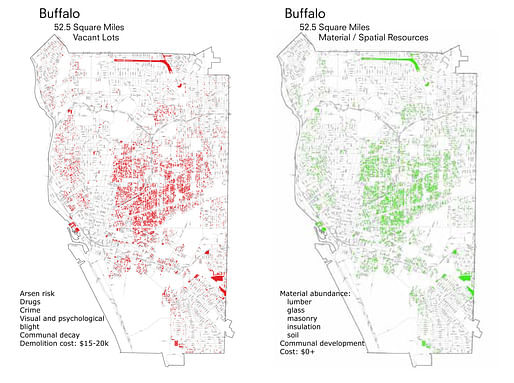
Contributed By: Matthieu Bain and Andrew Perkins
Master of Architecture Thesis
How can the remains of a declining city be harvested and utilized to resuscitate space and sustain life?

In October, we purchased a house from the Buffalo Foreclosure auction for $800 and moved in almost immediately amongst the clutter and without running water, electricity, or heat. The project since has been about how to survive on the remains of this declining city, hence the appropriate title: Dwelling on Waste. We’ve had to address a number of basic concerns: heat, water, security, cooking...only using the discards and forgotten items of the people around us. As the weather warms and as we nail down main structural/leakage/comfort problems, these scavenged materials will begin to lend themselves to more generous spaces and applications. The following covers the events that led up to this, the beginning of our story...
How can the remains of a declining city be harvested and utilized to resuscitate space and sustain life? Vacancy is a vicious cycle. As properties are left abandoned, arson, drugs, and other crimes lead to an overall deterioration of the neighborhood - and more abandonment. But the remains of this deterioration are an abundant source of easily accessible space and material, which can be used to build stronger and more sustainable dwellings. Ultimately, this leads to a relationship in which the home is open to a constant flux in material organization, as opposed to the standard static model of isolation and rejection.

While searching for the home that will ultimately become the focus of the project, we are essentially homeless. And so, in September a series of squatting experiments is carried out about the city, the first being in a long-abandoned mini-golf course. The site is chosen for its isolation and proximity to an endless amount of building material: the refuse of garbage day in the surrounding neighborhood. Umbrellas, rugs, cardboard, and foam, among other things, are reclaimed from the curb. The often compromised condition of these things suggests new uses; the broken shaft of an outdoor umbrella provides a sharp point to drive into the ground and also produces a more appropriately sized shelter. The waste objects begin to take on architectural qualities. Small pieces of packing foam prove as an insulation layer between us and the cold ground. The inflatable pool, which was once used to contain water, is refitted as a roofing material meant to shed it.

Another camp along I-190 and the railroad tracks near Niagara St. explores the new possibilities set up by a chance in site and differing material palette. Along the backs of these buildings are materials of industrial character: segments of pipe, pallets, and corrugated fiberglass. In addition to thermal and rain barriers, exposure to the road and river bring problems of acoustics and privacy. The wealth of problems forces us to compromise our solutions and the shelter was insufficient. When returning to the shelter a week later, a new one was found in its place. Someone else needing refuge stumbled upon it and made it their own, introducing their own scavenged materials that were not there before and ultimately improving upon our design.

In surveying these abandoned spaces we start to familiarize ourselves with Buffalo’s neighborhoods and narrow down our prospects for a house. Reaching out to Buffalo ReUse, P.U.S.H, various city activists and speaking to city representatives regarding the ever-growing demolition list and October’s foreclosure auction broadens the possibilities. With 2,380 properties on the foreclosure list, we establish a set of criteria to narrow the list:
Is the cost within our strict budget?
Is it small enough for the two of us to manage?
Is it close to public transit?
Will the community be receptive to us?
Is the condition unlike this?:

Most of the properties can easily be accessed - many of them with back doors wide open (or missing entirely). Our list of houses is reduced to five as we head into the auction. Almost every property we had our eye on is either bypassed or sold to the first bidder uncontested, usually between $500- 1000. We’re able to get our first choice - a small single-family house on Buffalo’s East side, for $800.


Built in 1900, the house is small enough for us to handle. The large backyard provides possibilities for agriculture, landscaping, material storage, and recreation. The neighborhood, though struggling, contains a community house, cooperative garden, chicken coop, and tool library.

Almost immediately, we move in amongst the clutter. We make a place for all of the things in the house. We make a place for the clothes that are left behind, for the toys that are broken, for the scraps of paper with favorite holiday recipes scribbled on them, for English essays with sarcastic commentary in between the lines. We place all of these things back into the house and we place ourselves amongst them.
To be continued...
More information can be found at http://dwellingonwaste.blogspot.com/
Learn more about the research and creative activities of our enterprising students and faculty. At the School of Architecture and Planning, we engage with our local and global communities to push the boundaries of our disciplines and innovate the professions of architecture and planning.
2 Comments
Looking good Andrew! When are you going get Matta-Clark on it? Rupert (Trace)
Good to hear from you Rupert! This post really just covers from September to October last year. We've got further posts on the way about our struggles and triumphs living in and experimenting on the house. Stay tuned.
Block this user
Are you sure you want to block this user and hide all related comments throughout the site?
Archinect
This is your first comment on Archinect. Your comment will be visible once approved.